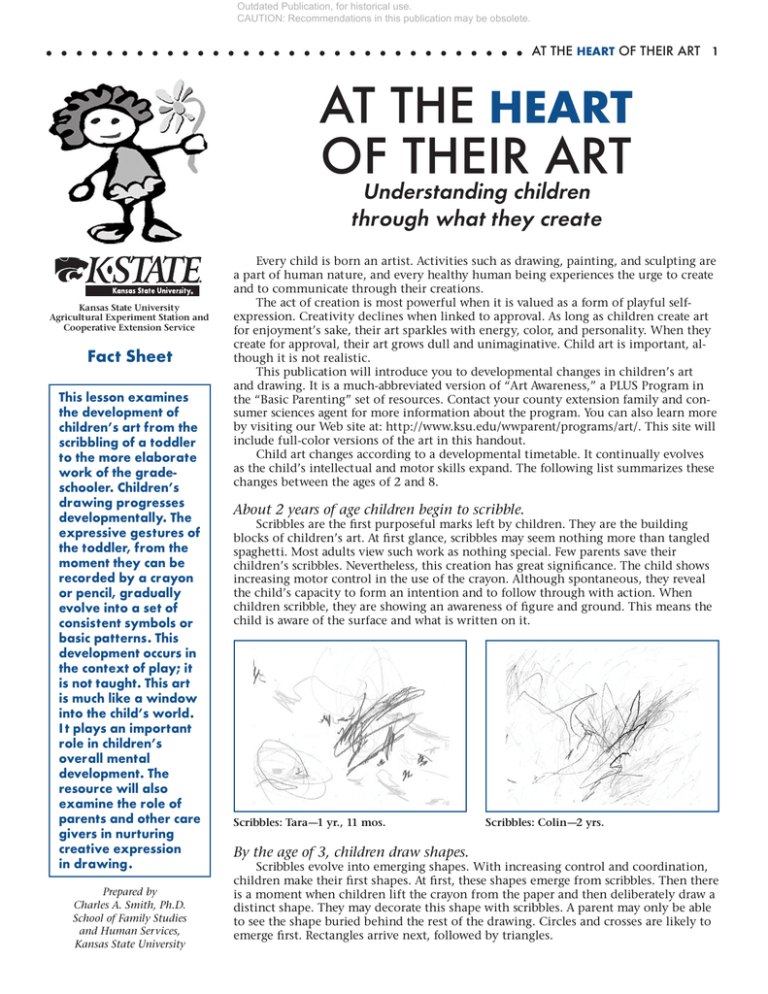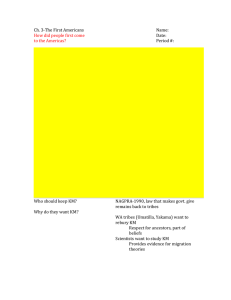
Outdated Publication, for historical use.
CAUTION: Recommendations in this publication may be obsolete.
AT THE HEART OF THEIR ART At the heart
of their art
Understanding children
through what they create
Kansas State University
Agricultural Experiment Station and
Cooperative Extension Service
Fact Sheet
This lesson examines
the development of
children’s art from the
scribbling of a toddler
to the more elaborate
work of the gradeschooler. Children’s
drawing progresses
developmentally. The
expressive gestures of
the toddler, from the
moment they can be
recorded by a crayon
or pencil, gradually
evolve into a set of
consistent symbols or
basic patterns. This
development occurs in
the context of play; it
is not taught. This art
is much like a window
into the child’s world.
I t plays an important
role in children’s
overall mental
development. The
resource will also
examine the role of
parents and other care
givers in nurturing
creative expression
in drawing.
Prepared by
Charles A. Smith, Ph.D.
School of Family Studies
and Human Services,
Kansas State University
Every child is born an artist. Activities such as drawing, painting, and sculpting are
a part of human nature, and every healthy human being experiences the urge to create
and to communicate through their creations.
The act of creation is most powerful when it is valued as a form of playful selfexpression. Creativity declines when linked to approval. As long as children create art
for enjoyment’s sake, their art sparkles with energy, color, and personality. When they
create for approval, their art grows dull and unimaginative. Child art is important, although it is not realistic.
This publication will introduce you to developmental changes in children’s art
and drawing. It is a much-abbreviated version of “Art Awareness,” a PLUS Program in
the “Basic Parenting” set of resources. Contact your county extension family and consumer sciences agent for more information about the program. You can also learn more
by visiting our Web site at: http://www.ksu.edu/wwparent/programs/art/. This site will
include full-color versions of the art in this handout.
Child art changes according to a developmental timetable. It continually evolves
as the child’s intellectual and motor skills expand. The following list summarizes these
changes between the ages of 2 and 8.
About 2 years of age children begin to scribble.
Scribbles are the first purposeful marks left by children. They are the building
blocks of children’s art. At first glance, scribbles may seem nothing more than tangled
spaghetti. Most adults view such work as nothing special. Few parents save their
children’s scribbles. Nevertheless, this creation has great significance. The child shows
increasing motor control in the use of the crayon. Although spontaneous, they reveal
the child’s capacity to form an intention and to follow through with action. When
children scribble, they are showing an awareness of figure and ground. This means the
child is aware of the surface and what is written on it.
Scribbles: Tara—1 yr., 11 mos.
By the age of 3, children draw shapes.
Scribbles: Colin—2 yrs.
Scribbles evolve into emerging shapes. With increasing control and coordination,
children make their first shapes. At first, these shapes emerge from scribbles. Then there
is a moment when children lift the crayon from the paper and then deliberately draw a
distinct shape. They may decorate this shape with scribbles. A parent may only be able
to see the shape buried behind the rest of the drawing. Circles and crosses are likely to
emerge first. Rectangles arrive next, followed by triangles.
Outdated Publication, for historical use.
CAUTION: Recommendations in this publication may be obsolete.
PARTICIPANT’S GUIDE
Emerging shapes: Tucker—3 yrs.
Emerging shapes: Bill—2 yrs.
Between 3 and 5 years, children draw mandalas.
The period of 3 to 5 years reveals tremendous gains in artistic ability. Soon after
drawing embedded and distinct shapes, children will draw their first mandalas. Mandalas are two or more shapes with a common center. Mandala is a Sanskrit word that
means “magic circle.” Two circles, one inside the other, are a mandala. So is a rectangle
with a cross through the center. Humans have created mandalas from the beginning:
They have been carved upon stones in the jungle, etched on the walls in prehistoric
caves, and painted on the facades of elaborate temples. They are among the oldest magical and religious symbols throughout our history. Yet they are drawn spontaneously by
a 3-year-old clutching a fat crayon. Children draw mandalas entirely on their own, without coaching of any kind. All they need is a drawing tool and a surface.
Mandala: Sarah—5 yrs.
Mandala: Sarah—5 yrs.
Between 3 and 5 years, children draw suns and radials.
Close after the appearance of mandalas, children begin to draw suns and radials.
Suns begin as circular shapes crossed with lines. The center markings soon disappear,
and the lines cross only the outside of the shape. Radials are made up of a series of
lines that spray out from a point. These two new features show that children are
experimenting with their rapidly growing control.
Suns: Sarah—3 yrs.
Suns: Unknown—4 yrs.1
1 Taken from Kellogg (1967), p. 54.
Outdated Publication, for historical use.
CAUTION: Recommendations in this publication may be obsolete.
AT THE HEART OF THEIR ART Between 3 and 5 years, children draw aggregates.
Aggregates are three or more shapes integrated as a unit. A recognizable, personal
style begins to appear. Parents who are familiar with their child’s work can probably
pick it out in a showcase of many children’s art. Aggregates constitute the bulk of child
art between ages 3 and 5. They are not simply a hodgepodge of forms. Each
reveals a child’s preference for balance and symmetry. Children perceive and remember balanced line formations more easily than other formations.
Aggregates: Sarah—3 yrs.
Aggregates: Sarah—5 yrs.
Between 4 and 5 years, children draw people.
Mandalas and suns evolve into human forms. The first drawings of people seem
rather inhuman. Rays of the sun become arms, legs, and hair. Before the child reaches
age 6, most drawings of humans are made to fit into an implied circle or one of its
variations. The circle represents the trunk and head, but the face predominates. Eyes are
especially important. At this stage, children are not trying to draw a human likeness.
Their first person is a representation drawn in a way that looks right and is
pleasing to them.
Person: Bill—4 yrs.
Person: Hunter—5 yrs.
Between 4 and 6 years, children draw pictures.
Between the ages of 4 and 5, most children arrive at the early pictorial stage in the
development of their art. Their focus is on individual objects. Besides people, children
begin to create animals. Their animals stand up firmly on two legs instead of crouching
down on all fours. Trees may look like armless humans. Soon flowers and leaves may be
added. A triangle set on a square is called a boat. A rectangle or square perched on two
circles is a car or a wagon. Often, the child is simply drawing designs of squares and
triangles, not real things. Adults are eager to label them as representations before the
child intentionally does so.
Outdated Publication, for historical use.
CAUTION: Recommendations in this publication may be obsolete.
PARTICIPANT’S GUIDE
Bibliography
Gardner, H. (1980). Artful
scribbles: The significance
of children’s drawings. New
York: Basic Books.
Goodnow, J. (1977). Children
drawing. Cambridge, MA:
Harvard University Press.
Kellogg, R. (1970). Analyzing
children’s art. Palo Alto, CA:
Mayfield.
Kellogg, R. (1967). The psychology of children’s art. New
York, NY: CRM-Random
House.
Krampen, M. (1991). Children’s
drawings: Iconic coding of
the environment. New York,
NY: Plenum Press.
Levick, M.F. (1986). Mommy,
daddy, look at what I’m
saying: What children are
telling you through their art.
New York, NY: M. Evans.
Picture: Colton—5 yrs.
Picture: Kaycee—5 yrs.
Between 5 and 7 years children draw scenes.
During the early pictorial stage, children paint or draw people, houses, and trees
primarily as designs. Sometimes, they may purposefully draw such representations. Not
until they are 5 or 6 years old do their pictures begin to tell a story. At a more mature
picture stage, children create scenes. A house may be painted on a hill, sheltered by a
tree. Instead of individual objects, the picture is a collection brought together around
a theme. At this stage, the child’s art begins to reveal how they perceive and feel about
the world around them.
Mortensen, K.V. (1991). Form
and content in children’s human figure drawings: Development, sex differences, and
body experience. New York:
New York University Press.
Thomas, G.V. (1990). An introduction to children’s drawings. New York: Haverster
Wheatsheaf.
Scene: Kirste—8 yrs.
Scene: Tiffany—9 yrs.
Collecting children’s art is a great way to better understand them and how they view
the world. Children do not need to be taught how to draw. In fact, we can learn a great
deal from the spontaneity, energy, and life they invest in their creations.
The author would like to thank
Judy Fullmer and the Kansas Association for Family and Community Education for their help in obtaining samples of art work.
Brand names appearing in this publication are for product identification purposes only. No endorsement is intended,
nor is criticism implied of similar products not mentioned.
Publications from Kansas State University are available on the World Wide Web at: http://www.oznet.ksu.edu
Contents of this publication may be freely reproduced for educational purposes. All other rights reserved.
In each case, credit Charles Smith, “At the Heart of Their Art,” Kansas State University, October 1999.
Kansas State University Agricultural Experiment Station and Cooperative Extension Service
MF-2414
October 1999
It is the policy of Kansas State University Agricultural Experiment Station and Cooperative Extension Service that all persons shall have equal opportunity and access to its educational programs, services, activities, and materials without regard to race, color, religion, national origin, sex, age or
disability. Kansas State University is an equal opportunity organization. Issued in furtherance of Cooperative Extension Work, Acts of May 8 and June
30, 1914, as amended. Kansas State University, County Extension Councils, Extension Districts, and United States Department of Agriculture Cooperating, Marc A. Johnson, Director.
File code: Human Development and Family Relations—2







